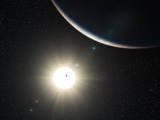|
|
TODAY.AZ / Weird / Interesting
Multi-planet system discovered 100 light years away
26 August 2010 [11:35] - TODAY.AZ
Scientists said Tuesday they have identified a sun-like star with as many as seven different planets – including one that might be the smallest ever found outside the solar system.
 If confirmed, the planetary system around HD 10180, a star more than 100 light years distant, would be the richest ever discovered. One astronomer says it is part of a growing body of evidence that the universe is full of planets – and that several could be similar to our own.
If confirmed, the planetary system around HD 10180, a star more than 100 light years distant, would be the richest ever discovered. One astronomer says it is part of a growing body of evidence that the universe is full of planets – and that several could be similar to our own.“The really nice thing about finding systems like this is that it shows that there are many more out there,” said Alan Boss, of the Washington-based Carnegie Institution for Science, who was not involved with the find. “Mother Nature really had fun making planets.”
Although most of the planets identified are large – about 13 to 25 times the mass of our home – those behind the discovery, announced Tuesday at an international conference in France, say they are nearly certain they have identified one only 1.4 times the size of Earth.
Planets found outside the solar system are called “exoplanets” and this would be the smallest one ever spotted. Scientists have been successfully hunting exoplanets for about 15 years, and they have now catalogued some 450. But most finds have been limited to one or two or three planets per star, usually gargantuan balls of gas similar to Jupiter or Saturn.
But at up to seven planets, the new discovery nearly matches our own solar system, which counts eight. Christophe Lovis of Geneva University, one of the scientists behind the find, said the first five around HD 10180 were most comparable to Neptune. “They are made essentially of rocks and ice. They have a solid core. But on top of that is a layer of gas, of hydrogen and helium most likely,” he said. “They are probably not habitable.”
The sixth is possibly a Saturn-like planet, while the seventh, the smallest, would be so close to its star that its “year” would take just over a day. Lovis and his team have not been able to observe the planets directly, which is typical. Few planets can be seen against the blazing light given off by their much more massive parent stars. The European Southern Observatory compares the challenge to “spotting a dim candle in front of a raging forest fire.”
So the scientists used the observatory’s 3.6-meter telescope at La Silla, Chile, to study the star itself. Over six years, they took 190 measurements, checking it for the telltale wobbling caused by the gravitational forces of nearby planets.
Boss noted that the method was “biased toward finding the big guys” because the greater the planet, the greater its gravity and the more it makes its parent star wobble. But he said the discovery showed that finding smaller planets was still possible.
“This field has gone from zero to close to 500 planets in just 15 years,” he said. “Fifteen years ago we did not know about the big guys. Earth-like planets are going to be quite commonplace.”
The find was made by researchers from Switzerland, France, Germany and Portugal and has been submitted to the journal Astronomy and Astrophysics.
/Hurriyet Daily News/
URL: http://www.today.az/news/interesting/72631.html
 Print version
Print version
Views: 2642
Connect with us. Get latest news and updates.
See Also
- 19 February 2025 [22:20]
Visa and Mastercard can return to Russia, but with restrictions - 05 February 2025 [19:41]
Japan plans to negotiate with Trump to increase LNG imports from United States - 23 January 2025 [23:20]
Dubai once again named cleanest city in the world - 06 December 2024 [22:20]
Are scented candles harmful to health? - 23 November 2024 [14:11]
Magnitude 4.5 earthquake hits Azerbaijan's Lachin - 20 November 2024 [23:30]
Launch vehicle with prototype of Starship made its sixth test flight - 27 October 2024 [09:00]
Fuel prices expected to rise in Sweden - 24 October 2024 [19:14]
Turkiye strikes terror targets in Iraq and Syria - 23 October 2024 [23:46]
Kazakhstan supplied almost entire volume of oil planned for 2024 to Germany in 9 months - 23 October 2024 [22:17]
Taiwan reported passage of Chinese Navy aircraft carrier near island
Most Popular
 Parallel worlds of European Union and South Caucasus
Parallel worlds of European Union and South Caucasus
 Hasty visit to Germany - what did Pashinyan lose from Merz?
Hasty visit to Germany - what did Pashinyan lose from Merz?
 Afghanistan expands international flight connections
Afghanistan expands international flight connections
 ICESCO Director-General to pay visit to Turkic Culture and Heritage Foundation
ICESCO Director-General to pay visit to Turkic Culture and Heritage Foundation
 The intricacies of diplomacy: why is the 3+3 meeting postponed?
The intricacies of diplomacy: why is the 3+3 meeting postponed?
 President Ilham Aliyev holds one-on-one and extended meetings with Chairman of Slovak National Council
President Ilham Aliyev holds one-on-one and extended meetings with Chairman of Slovak National Council
 Lewis Hamilton sets unusual record
Lewis Hamilton sets unusual record
